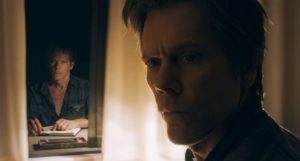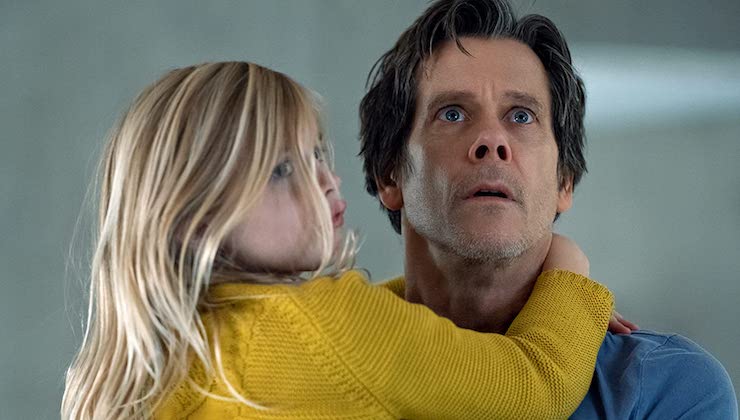sample heading
The opening hour of You Should Have Left gives me all the plot elements I love in horror: believable human conflicts that set a base level of tension, characters who are rich enough that I won’t feel too bad when terrible stuff happens to them, a precocious child, creepy locals, and unexpected haunted house.
Unfortunately it doesn’t quite stick the landing.
But first, let talk about the good stuff!
The age difference between Kevin Bacon and Amanda Seyfried was discussed a bit last week, and I was excited to see that the movie made that part of the central conflict of the film. Rather than just giving us an intergenerational couple and expecting us to roll with it, the film starts off exploring how that gap affects the couple’s relationship. Bacon’s Theo Conroy has retired after a very successful career doing some nebulous rich white man stuff, and Seyfried’s Susanna is an actor. He’s supportive of Susanna’s career, and steps up to be a stay-at-home dad to their daughter Ella—but he’s very visibly exhausted by her endless fonts of energy. He wishes Susanna wasn’t on her phone so much—but he’s also willing to work on The Deep Emotional Wound That Haunts Him by using a meditation app and journaling.
And yes, The Deep Emotional Wound That Haunts Him factors into the horror movie elements later, but saying more would spoil things.
When I say the characters are rich, I mean rich enough that after a slight tiff they decide to, spur of the moment, rent a luxury house in rural Wales, fly to the UK from L.A. with their five-year-old child, rent a car, drive to the house, and just stay for a while before Susanna has to leave for her latest film gig. When they begin to suspect that There’s Something Wrong With The House, it’s not a problem for them to bail on the luxury rental and go to a hotel. This might not seem like such an important element, but it makes the movie a lot more fun if I’m already seething in jealousy in my un-air-conditioned Brooklyn apartment, actively rooting for the house to do its worst.

The precocious kid, Ella, is played by Avery Essex, and she is great. Slightly unrealistic in that she’s surprisingly calm about all the travel and mom being away for movie gigs all the time, but delightfully creepy when she has to shoulder the tradition of being the first character to know something’s wrong. And this might sound absurdly specific, but she really seemed like a kid that had been raised by Theo and Susanna. I have a few friends who are the children of intergenerational marriages, and Ella’s specific rapport with each parent felt very true to me. It was a bit of realism I wasn’t expecting, and when you’re dealing with supernatural horror you need all the realism you can get to ground it.
The creepy locals are indeed creepy but with the added bonus of Welsh accents. That’s worth at least 10 horror movie points.
Finally, my favorite part of the film: the unexpected haunted house! Rather than giving us a big spooky house with creaking doors or a dank basement, the movies sends the Conroys to a gorgeous, modern, minimalist luxury rental. From the outside the house is all sharp angles and cantilevering; the interior is sleek and positively IKEAn, with walls covered in light wood paneling, white couches, and open, lofted bedrooms. Much like And Then There Were None (which for my money is far more a horror story than a mystery) part of the scariness lies in the fact that ghosts and evil spirits simply seem out of place in a modern house. Think of a movie like Paranormal Activity—would it have been frightening at all if it took place in a crumbling Victorian manor? The terror lay in the idea that this could be your crappy starter townhome. Think of the opening of The Blair Witch Project, or the ordinary middle-class homes in The Ring. That sterility is supposed to give us a certain kind of safety, like the modern-day equivalent of a campfire holding the wolves at bay. Evil spirits aren’t supposed to be able to exist in stucco duplexes. That gap between the Conroys’ increasing certainty that there’s something wrong with the house, and the fact that there can’t be, this is the 21st Century! creates a delicious tension.
This mood comes through most clearly in the study—rather than the book-lined library one might expect from a haunted house, one wall is lined with a scattering of magazine racks, each holding a single book. Rather than a desk there’s a low table with a student lamp, and yet another white couch. It is exactly the kind of study a himbo architect would use in a romcom. It’s just that, sometimes, there’s an extra door in the wall. And if you open the door there’s a jagged wooden staircase that goes down, and down, and down.
The first hour of the film works beautifully, layering in the mundane tensions between Theo and Susanna and the growing creepiness of the house until it tips fully over into horror. And that’s where I think it goes a little off. There are always so many choices to make in this genre—especially when you’re managing a haunted house. How soon do you let your characters realize they’re in a horror story, if you allow them to realize it at all? How do you sustain the suspense as evidence piles up that something’s wrong? What is the source of the haunting? Did innocent people stumble into a place of evil, or did they bring their own ghosts with them? Is there one inciting incident or curse that triggered the haunting? Where I think You Should Have Left missteps is that it ably mushes several of these possibilities together, keeps us guessing about why exactly this story is scary, and then suddenly shows its hand with a reveal as abrupt as a Scooby Doo villain’s.
I loved the opening, and truly hoped I was watching a great new horror movie until that disappointing resolution, so after much mulling I’m recommending it, but with the suggestion that you go in prepared to write your own Choose Your Own Adventure-style ending that plays with all of the movie’s creepy potential.
And watch out for that extra door.
You Should Have Left is available via video on demand from Blumhouse Productions.



